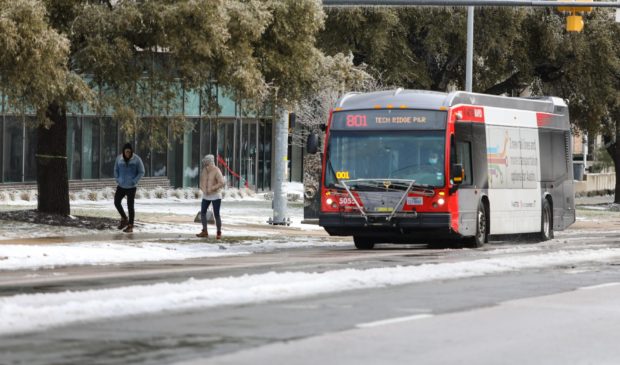Tuesday, January 11, 2022 by
Nathan Bernier, KUT During last February’s deadly winter storm, Capital Metropolitan Transportation Authority workers sheltered shivering Austinites and drove dialysis patients along treacherous roads to lifesaving treatments.
But the agency had unrealistic expectations of how long it could operate in the worsening conditions, frustrating passengers and leaving buses abandoned on frozen streets.
Keeping the report under wraps “was a misstep,” said Ann Kitchen, a Capital Metro board member who also represents Austin City Council District 5. “I don’t think it was deliberate, but I do think it was not best practice.”
The agency said it didn’t release the after-action report to the public because the analysis was originally intended to inform internal operations and may have contained sensitive security information. However, Capital Metro acknowledged an internal review found there was no sensitive information in the report.
“It’s something that we weren’t philosophically opposed to making public,” Capital Metro deputy CEO Dottie Watkins said. “We just hadn’t thought of it in advance.”
The after-action report by North Carolina-based IEM, an emergency management consultancy, portrays an agency that adopted an “all hands on deck posture” to provide service during unprecedented conditions for Capital Metro.
But because the storm was so severe and lasted so long, the agency struggled to keep running. Pipes began bursting at operations centers. As parking lots froze and the power went out, operations ground to a halt.
“Service-restoration timelines communicated to the public were too optimistic for the weather conditions,” the report outlined in one of many critiques of the agency. “To maintain trust and establish clear expectations with the public, Capital Metro should have been more conservative with communicating restoration times.”
The report found that employees camped out at Capital Metro facilities during the storm didn’t have enough supplies, including cots, sleeping bags, food and water.
“Many interview participants noted that their departments used to have supplies of cots and Meals-Ready-To-Eat (MREs),” IEM wrote, “but these items were not accessible or no longer available for use in the incident.”
But, overall, IEM said Capital Metro launched a strong, centralized emergency operation to coordinate response activities. The agency brought people to warming centers, transported patients to critical medical appointments, distributed cases of water and regularly checked in with employees to make sure they had essential services.
“Capital Metro employees who were able to report to perform their duties provided exemplary support to the agency and community,” the report found.
In one vivid example, the team behind Pickup – Capital Metro’s on-demand transit service – immediately realized the impact power outages would have on some clients and started regularly contacting dialysis centers to see if they were open.
“By and large, I think the public can be very proud of the role that Cap Metro played in responding and trying to ease the suffering in our community,” Capital Metro Board Chair Wade Cooper said.
“There’s always room for improvement,” Kitchen said. “The recommendations made will make Cap Metro stronger and more able to support the community during an emergency and a disaster.”
Capital Metro says it’s already begun implementing some of the report’s recommendations. The agency is beefing up its decision-making process on when to suspend service. It’s also buying snow equipment like chains to put on tires. Some recently purchased maintenance trucks can be equipped with snow plows if necessary.
“We were quite proud of our ability to (respond to emergencies) during the winter storms,” Watkins said. “I’m hopeful that if this ever hits us again, we’ll be able to do even more.”
This story was produced as part of the Austin Monitor’s reporting partnership with KUT.
The Austin Monitor’s work is made possible by donations from the community. Though our reporting covers donors from time to time, we are careful to keep business and editorial efforts separate while maintaining transparency. A complete list of donors is available here, and our code of ethics is explained here.











